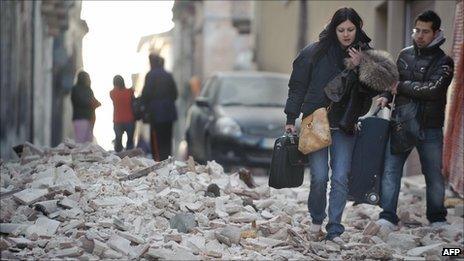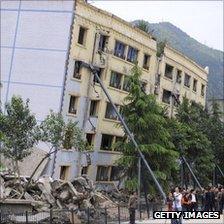Can we predict when and where quakes will strike?
- Published

Seismologists try to manage the risk of building damage and loss of life
This week, six seismologists go on trial for the manslaughter of 309 people, who died as a result of the 2009 earthquake in l'Aquila, Italy.
The prosecution holds that the scientists should have advised the population of l'Aquila of the impending earthquake risk.
But is it possible to pinpoint the time and location of an earthquake with enough accuracy to guide an effective evacuation?
There are continuing calls for seismologists to predict where and when a large earthquake will occur, to allow complete evacuation of threatened areas.
Predicting an earthquake with this level of precision is extremely difficult, because of the variation in geology and other factors that are unique to each location.
Attempts have been made, however, to look for signals that indicate a large earthquake is about to happen, with variable success.
Historically, animals have been thought to be able to sense impending earthquakes.
Noticeably erratic behaviour of pets, and mass movement of wild animals like rats, snakes and toads have been observed prior to several large earthquakes in the past.
Following the l'Aquila quake, researchers published a study in the Journal of Zoology documenting the unusual movement of toads away from their breeding colony.
But scientists have been unable to use this anecdotal evidence to predict events.
The behaviour of animals is affected by too many factors, including hunger, territory and weather, and so their erratic movements can only be attributed to earthquakes in hindsight.
Precursor events
When a large amount of stress is built up in the Earth's crust, it will mostly be released in a single large earthquake, but some smaller-scale cracking in the build-up to the break will result in precursor earthquakes.
These small quakes precede around half of all large earthquakes, and can continue for days to months before the big break.
Some scientists have even gone so far as to try to predict the location of the large earthquake by mapping the small tremors.
The "Mogi Doughnut Hypothesis" suggests that a circular pattern of small precursor quakes will precede a large earthquake emanating from the centre of that circle.
While half of the large earthquakes have precursor tremors, only around 5% of small earthquakes are associated with a large quake.
So even if small tremors are felt, this cannot be a reliable prediction that a large, devastating earthquake will follow.
"There is no scientific basis for making a prediction", said Dr Richard Walker of the University of Oxford.
In several cases, increased levels of radon gas have been observed in association with rock cracking that causes earthquakes.

Small ground movements sometimes precede a large quake
Radon is a natural, radioactive gas in the Earth's crust that is released and dissolves into groundwater when the rock breaks.
Similarly, when rock cracks, it can create new spaces in the crust, into which groundwater can flow.
Measurements of groundwater levels around earthquake-prone areas see sudden changes in the level of the water table as a result of this invisible cracking.
Unfortunately for earthquake prediction, both the radon emissions and water level changes can occur before, during, or after an earthquake, or not at all, depending on the particular stresses a rock is put under.
Advance warning systems
The minute changes in the movement, tilt, and the water, gas and chemical content of the ground associated with earthquake activity can be monitored on a long term scale.
Measuring devices have been integrated into early warning systems that can trigger an alarm when a certain amount of activity is recorded.
Such early warning systems have been installed in Japan, Mexico and Taiwan, where the population density and high earthquake risk pose a huge threat to people's lives.
But because of the nature of all of these precursor reactions, the systems may only be able to provide up to 30 seconds' advance warning.
"In the history of earthquake study, only one prediction has been successful", explains Dr Walker.
The magnitude 7.3 earthquake in 1975 in Haicheng, North China was predicted one day before it struck, allowing authorities to order evacuation of the city, saving many lives.
But the pattern of seismic activity that this prediction was based on has not resulted in a large earthquake since, and just a year later in 1976 a completely unanticipated magnitude 7.8 earthquake struck nearby Tangshan causing the death of over a quarter of a million people.
The "prediction" of the Haicheng quake was therefore just a lucky unrepeatable coincidence.
A major problem in the prediction of earthquake events that will require evacuation is the threat of issuing false alarms.
Scientists could warn of a large earthquake every time a potential precursor event is observed, however this would result in huge numbers of false alarms which put a strain on public resources and might ultimately reduce the public's trust in scientists.
"Earthquakes are complex natural processes with thousands of interacting factors, which makes accurate prediction of them virtually impossible," said Dr Walker.
Seismologists agree that the best way to limit the damage and loss of life resulting from a large earthquake is to predict and manage the longer-term risks in an earthquake-prone area. These include the likelihood of building collapsing and implementing emergency plans.
"Detailed scientific research has told us that each earthquake displays almost unique characteristics, preceded by foreshocks or small tremors, whereas others occur without warning. There simply are no rules to utilise in order to predict earthquakes," said Dr Dan Faulkner, senior lecturer in rock mechanics at the University of Liverpool.
"Earthquake prediction will only become possible with a detailed knowledge of the earthquake process. Even then, it may still be impossible."
- Published20 September 2011
- Published11 May 2011